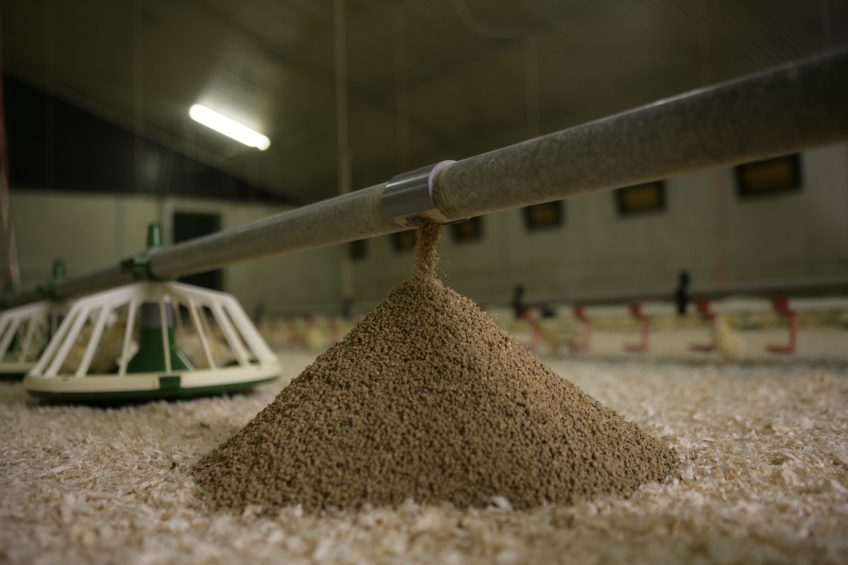More to feed’s physical quality than pellet durability

Delegates attending this year’s Northern Broiler Conference had to brave heavy snow, but were rewarded with a broad range of technical topics to improve production.
Ensuring poultry rations stimulate gizzard development is a far better way to increase feed conversion than focusing entirely on pellet durability.
According to Adam Sacranie, a nutritionist with Aviagen, it is important that the composition of feed aids broiler and breeders’ developing digestive systems to improve feed regulation as maturity approaches.
He described this composition as the microstructure, and durability of pellets as the macrostructure.
“From the perspective of the broiler or breeder, the digestive system experiences the feed as a mash,” says Dr Sacranie. “The pellet is just a delivery system, and that’s the reason that microstructure is so important.”
Why we pellet
Processing feed into pellets is done for a number of reasons, he explains. It increases feed intake, nutrient availability and can reduce wastage through spillage, when compared with a mash-based ration. Durability is an important measure of quality, and more pellets that make it to feed pans intact means more readily available nutrients across a shed, potentially improving flock uniformity.
The standard measure of durability is expressed as a percentage, where 90% would mean nine in 10 pellets remained intact, but 10% had crumbled into fines, or dust.
“With up to about 10% pellet fines, your feed conversion is not going to be dramatically affected,” explains Dr Sacranie, “But more than 10%, for every percent over that we can attribute 0.001 to 0.0015 point increase to feed conversion ratio.”
Sticking together
Pellet durability is aided in the UK by wheat which, as opposed to maize, has starches that are very good at gelatinising during the milling process, and scores above 90% are usually achievable, says Dr Sacranie. “In maize based diets it’s a real struggle and quite difficult to guarantee a high level of durability, in my experience it’s somewhere between 70-80%.”
A key influencing factor on durability is particle size before pelletisation, he adds, with finer feed making for stronger pellets. But it may not be the best nutritional strategy. “For those involved in performance on farm, we have to ask is this the best thing biologically speaking.”
In a well-functioning digestive tract there is a clear distinction between the gizzard and proventriculus, which together can be considered the stomach of birds. The gizzard is effectively a muscle that grinds feed and regulates its passage to the rest of the gut.
Work out
But, as with any other muscle, it needs developing and exercise, and coarse particles in feed are a good way to do so.
Without the regulation that a well-developed gizzard offers, nutrients such as starch pass straight into the lower gut where they can encourage bacterial populations’ growth.
“Very often spikes in water intake can be seen around 28 days and this is often because the gizzard has not been stimulated, so there’s a microfloral bloom in the lower gut, leading to wet litter and other issues.
“We want nutrients for growth not bacteria, and if we don’t stimulate the gizzard then we won’t control the flow of nutrients into the small intestines.”
Bigger gizzards
Moreover, work with Trouw Nutrition found that, while diets with some coarse insoluble fibre don’t affect growth, they do improve gizzard size relative to bodyweight. That improved gizzard condition has the potential to improve FCR, and regulate acidity.
A healthy gizzard can translate to a 4-to-5 point improvement in FCR, far outpacing the reduction in conversion from lower pellet durability.
“We should control pellet durability – don’t let it fall too much below 90% – but if we don’t pay attention to what is inside the pellet we can limit the digestive process.
“We need to stimulate the gizzard and it’s probably worth focusing on this rather than trying to achieve 95% durability. I’d be happier to accept 92% pellet durability rather than 96% if it came with some good structural elements in the feed,” suggests Dr Sacranie.
Conference bitesFeed compounder ABN will launch a new software platform for poultry farmers at the Pig & Poultry Fair. The firm’s Lucy Tovey said it would be a paid-for service that could go some way to replace paper flock record for poultry farmers, and give stakeholders such as vets, technicians and customers insights into flock performance in real time. Adrian Knoetz, a vet with Slate Hall Veterinary Services, gave a talk about runting and stunting – restricted growth – primarily caused by viral infections. He said many of the strains, such as reovirus, astrovirus and rotavirus, peaked and were shed before flock issues became apparent, so suspected crops or problem sheds should be tested before issues arise. The Animal and Plant Health Agency’s Doris Muella-Doblies reinforced the importance of biosecurity on poultry farms, highlighting in particular rodent control and food dip quality. On rats and mice, she said that a unit with a pest population could not hope to effectively control salmonella or campylobacter. She added that foot dips were totally ineffective if any organic matter got into them: “don’t rely on boot dips, they should never be considered a replacement for changing footwear when entering sheds.” |
Join 31,000+ subscribers
Subscribe to our newsletter to stay updated about all the need-to-know content in the poultry sector, three times a week. Beheer
Beheer











 WP Admin
WP Admin  Bewerk bericht
Bewerk bericht